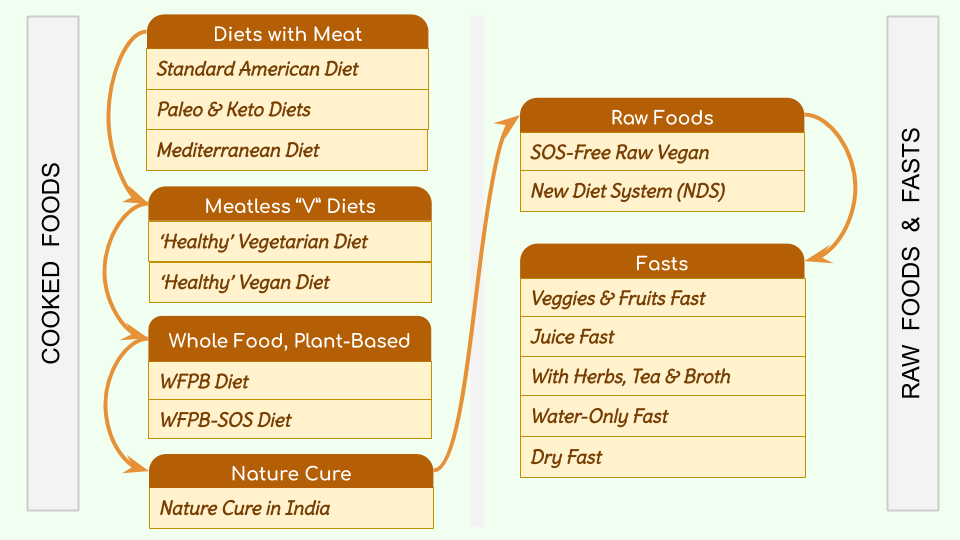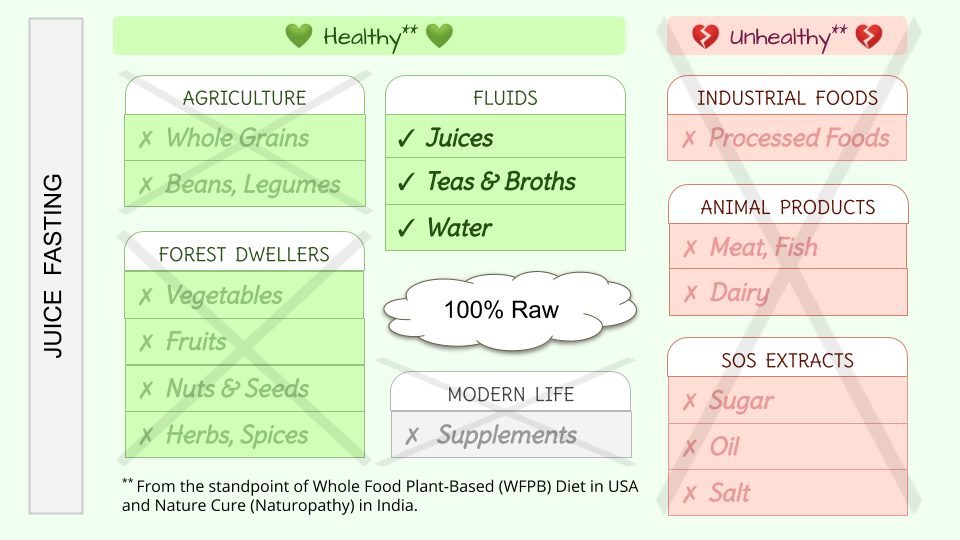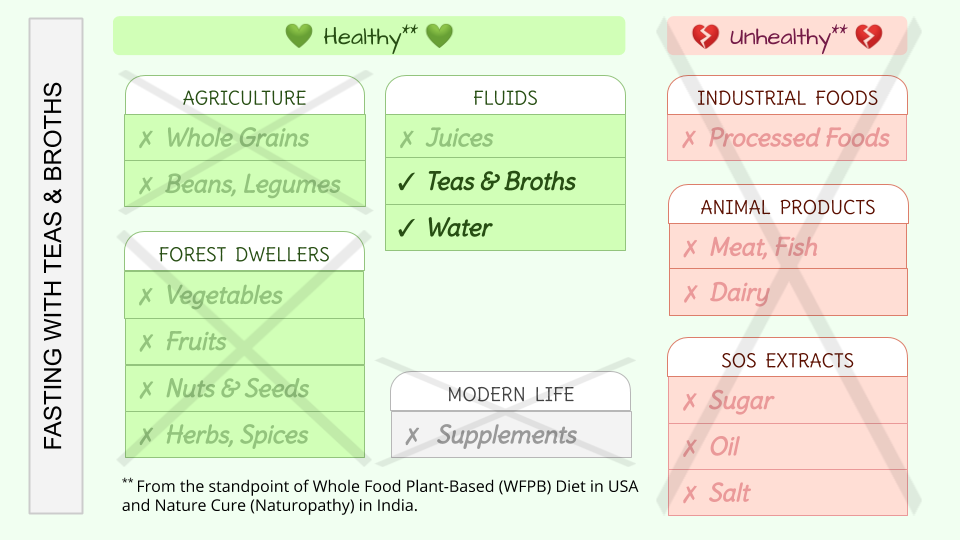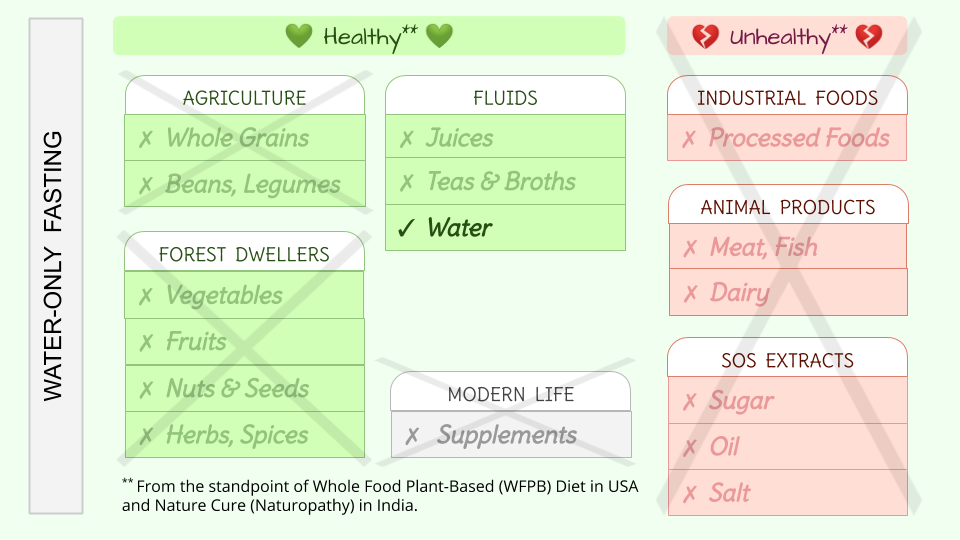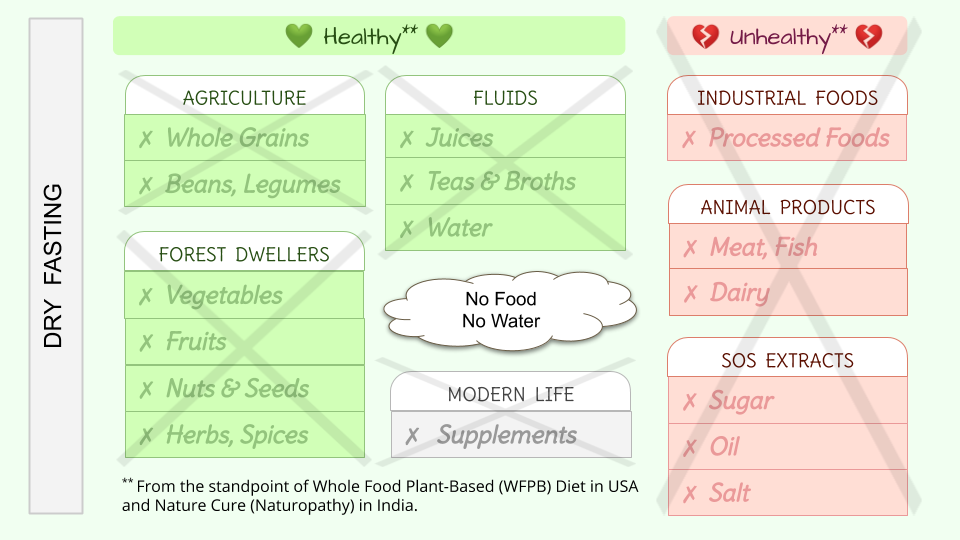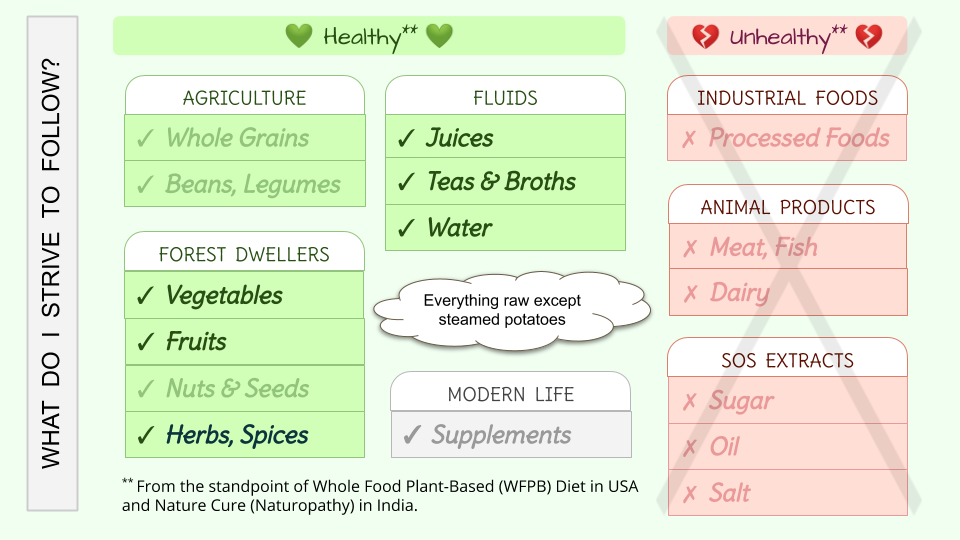This article is a continuation of Part 1: Spectrum of Diets in which diets listed below were discussed. This article (Part 2) focuses on raw foods and fasting protocols.
I like to visualize cooked food diets, raw food diets and fasting protocols as a sequence of eliminations. The first 7 steps of elimination were discussed in Part 1: Spectrum of Diets. In this article, we focus on Steps 8-14.
In Part 1: Spectrum of Diets, WFPB-SOS was described. For details, see
Summary of WFPB-SOS: WFPB-SOS has no Industrial Foods (Processed Foods), no Animal Products (no Meat, Fish, Dairy or Eggs), no SOS Extracts (no Sugar, Oil or Salt). WFPB-SOS focuses on Whole Grains, Beans & Legumes, Vegetables, Fruits, Nuts & Seeds, Herbs & Spices. This food system serves as the starting point of Steps 8-14.
We will go through Steps 8-14 one by one. But let's understand the big picture first. I am fascinated by both raw foods and fasting! Both ideas have a long and rich history. Many communities have practiced them worldwide over the ages. Today, both practices are relatively rare.
Contrasting Beliefs: In the modern world, the idea of raw foods and fasting for robust health is counter-intuitive. Collectively, we believe that cooking is essential and makes food easier to digest. Raw food communities believe exactly the opposite: cooking is non-essential and raw foods are easier to digest! Also, the commonly-held belief is that when disease strikes, eating is important so that our body has energy to fight off disease. Fasting proponents explain that when disease strikes, it's important to give our body complete rest; even our digestive system needs rest so that we can devote all of our energy to healing! Which approach makes sense? Raw or cooked? To eat or not to eat when sick?
Tricky to Execute: In later sections of this article, I'll showcase examples of healing protocols centered around raw foods and fasting. Such protocols have been developed in both the East and the West. Personally, I am convinced that there is immense value in these ideas. Unfortunately, scientific studies are lacking, so both raw food and fasting protocols are tricky to execute! Tricky in the sense that clear 'roadmaps' (safe guidelines) are not available. So it's possible to hurt ourselves unknowingly.
One of my goals in writing about various diets and fasts is to highlight the challenges that are faced by people today when they adopt raw foods and fasting. It is my sincere hope that in the next 20 to 50 years, some money is invested in scientific research so that safe protocols for raw foods and fasting may be developed. Today, I feel that we have to be a pioneer or an adventurer to dabble in these protocols.
Whole Food, Plant-Based (WFPB) Diet: As of 2019, WFPB does not advocate 100% raw foods or fasting. Some individual WFPB doctors do encourage fasting but not the community as a whole. For example, if we visit Forks Over Knives website, they don't recommend 100% raw foods or fasting.
WFPB encourages a combination of raw and cooked foods - it's okay to consume a high percentage of foods as raw but going 100% raw is not advocated. Why? We don't have enough scientific studies for 100% raw food systems. And nutritional deficiences have sometimes been discovered in individuals who adopted these systems. Also, raw food communities are small-sized and loosely organized. There is no single, large-sized body that comes up with raw food guidelines for everybody! So there are no clear 'roadmaps' (safe protocols). In contrast, WFPB has clear guidelines, conferences, books and recipe books devoted to its exposition.
Are Raw Foods and Fasting for Pioneers and Adventurers? I think so! I encourage all of my friends to follow WFPB Diet because it has clear guidelines; it is backed by a lot of scientific evidence; recipe books and support groups in place. WFPB-SOS Diet and Nature Cure (Naturopathy) Diet guidelines are very similar to WFPB guidelines, so these two systems are also okay! But for adopting raw foods and fasting protocols (steps 8-14), we need the mindset of a pioneer and an adventurer who is comfortable with food-related self-experiments. Since I have that kind of personality, I have dabbled in these. Below, I share with you what I've learnt so far.
By adopting Steps 1-7 plus Step 8 (No Cooking), we become SOS-Free Raw Vegan. SOS-Free means no-Sugar, no-Oil, no-Salt. By raw is meant that we don't heat foods to temperatures beyond 104-118℉ (40-48℃). For details, see
100% Raw or High Raw? The term High Raw means that a high percentage of calories are derived from raw foods but we're not 100% raw. The term Raw Vegan is somewhat confusing — it sometimes refers to 100% raw foods and sometimes to High Raw Vegan.
How to eat raw? Most Vegetables and Fruits may be consumed raw. Nuts and seeds may be soaked overnight. Herbs and Spices can be eaten fresh, soaked or ground. Grains, Pseudo-Grains, Beans & Legumes may be sprouted. In addition, many Raw Vegans adopt low temperature dehydration (to mimic solar dehydration), fermentation, smoothie making and juicing.
How Important is Raw? Some people adopt Step 8 (No Cooking) much earlier, say after Step 6, or after Step 5, or as early as Step 2; some communities eat raw Meat, raw Fish and raw Eggs! Some people might insist that Step 8 (No Cooking — Eat Raw) is more important than any other step. From the limited knowledge I have, I'm inclined to believe that the choice of ingredients is far more important than cooking technique. For example, being vegan is more important than being raw.
Elimination of both grains and beans is an unusual step. It is rarely done even among raw vegan communities who prefer to eat sprouted grains (or sprouted pseudo-grains) and sprouted beans. But grains and beans can indeed be eliminated and we still have a nutritionally complete system! [I learnt this from a first-hand conversation with Dr Goldhamer from True North Health Center, Santa Rosa, California. I then did analysis in Cronometer to verify that all macro- and micro-nutrients are available in Vegetables (and a few Sea Vegetables), Fruits, Nuts & Seeds, and a few supplements. ]
In India, we have a fascinating raw food system called New Diet System (NDS) in which we are encouraged to consume predominantly juicy Vegetables, juicy Fruits, some Nuts & Seeds, and some Herbs & Spices. For beginners, this may be difficult to follow, so sprouted Grains, Beans & Legumes are also included. Also, beginners may consume one cooked meal every day (dinner) but with only 30% of cooked foods. In addition, daily dry fasting in the morning and Time Restricted Fasting (eating all our foods in a narrow time window, say, 6-8 hours) is encouraged. For the first 8-12 weeks, daily enemas are required.
On the whole, New Diet System (NDS) is an unusual and difficult system. But I have watched several success story videos and I'm awed by them. For more details, see
Fasting with Vegetables and Fruits is sometimes done as a preparatory step for Juice Fasting or Water-Only Fasting.
Juice fasts revolve around home-made vegetable juices with a little bit of fruit, and some herbs for flavor. Juice fasts spiked in popularity in the West after the documentary "Fat, Sick and Nearly Dead" came out in 2010.
A variety of fasting regimens have been developed over the ages in different parts of the world. Today, a large number of companies have mushroomed with various packages for 'cleanses' and 'detox'. I don't know much about fasting protocols with teas and broths, except that the Buchinger Institue in Germany conducts such fasts. It is mentioned in the article on Water-Only Fasting in the next section.
Water-Only Fasting is difficult in the modern world, especially with the foods that most of us habitually consume (copious amounts of processed foods, meat, fish, dairy & eggs, sugars, salts, oils). So this should be done only under medical supervision. In fact, for somebody with a serious sickness, even Step 11 (Juice Fasting) could be dangerous, so should be done under medical supervision. For details, see
Few people practice dry fasting today; it was a well recognized intervention in the past. Said to be super healing. For example, Nirjala Ekadasi is a traditional dry fasting day practiced in almost every state of India — we don't eat or drink anything for about 36 hours. Ramadan fasting also entails dry fasting.
In the modern world, given the foods that we habitually consume, dry fasting could be potentially dangerous. My understanding is that our internal organs should be ready for such a fast. That requires cleaning up our regular food habits substantially over several months through adoption of Steps 1 through 10, along with practice of Steps 11-13 (different types of fasts) before attemping a dry fast.
My personal philosophy for dry fasting is: Don't force it! Don't will it! If it happens with ease (with no adverse symptoms, without even mild discomforts), allow it to happen and be thankful that you got to experience it!
Since 2012, I have followed a Whole Food, Plant-Based (WFPB) Diet. In 2019, I started experimented with a raw vegan system called New Diet System (NDS) — it is promoted by Shri B V Chouhan in Gujarat, India. I am able to follow the system to some degree, but not fully.
Grains and Beans: Advanced practitioners of NDS don't consume any grains and beans, I hear. I haven't reached there yet. I consume sprouted pseudo-grains (amaranth, buckwheat, quinoa) and sprouted beans & legumes (lentils, mung beans, garbanzo beans).
Supplements: The only changes I have introduced for myself that are not in harmony with NDS guidelines are supplementation. I take Vitamin B12 and Vitamin D supplements. I feel both are necessary. Modern plant-based, whole foods are 'super-clean' and B12 deficient. Also, the sun in California is different from the sun in tropical countries. There is research showing that people of Indian sub-continent origin develop Vitamin D deficiency when they migrate to northern latitude like Europe and North America.
Cooking: I consume one cooked food every day: steamed potatoes. Over time, as I learn more, I might replace this by a raw food.
Raw Food Journey: Adapting to a raw food lifestyle was quite a challenge for me. My personal journey is described here:
Fasting: I have done a few juice-fasts and water-only fasts. My personal experiences are described here:
I encourage my friends to pick up knowledge of various food systems and fasting protocols outlined above and find a sweet spot that is in harmony with their personal health goals, their circumstances (family, work life, social relationships), their spiritual goals, and so on. In fact, it is best to pick up this knowledge when we are in good health instead of scrambling for this knowledge when some disease strikes!
Raw Foods & Fasting: these are difficult protocols to adopt safely. As of today, we have to be a pioneer or an adventurer to do self-experiments. Even though many websites and books and YouTube channels discuss both raw foods and fasting, I don't believe that we have good 'roadmaps' (safe protocols) yet. It appears that many people jump to raw foods and fasting protocols without adequate knowledge, guidance and community support. That could be damaging to our health. So please take care.
It is my sincere hope that in coming decades, more research funding is channelized towards studying raw foods and fasting so that safe protocols for various population groups are developed and their benefits become clearer and well known.
Whole Food Plant-Based Diet: I encourage my friends to adopt a Whole Food, Plant-Based (WFPB) Diet for sure. I am so happy that this food system has started becoming popular! It's a wonderful food system with so much scientific research backing it up. As of 2019, the term WFPB continues to be far less known when compared to the term 'Vegan'. However, a fair number of doctors, nutritionists and communities are actively bringing it to the masses. With so many documentaries, recipe books and FaceBook communities coming up, WFPB should become well known in another decade or two.
Peace & Joy: I really hope that mental health benefits of Whole Food Plant-Based, raw foods and fasting protocols are also studied scientifically and become more well known.
Sending everybody good wishes!

 Instagram
Instagram YouTube
YouTube